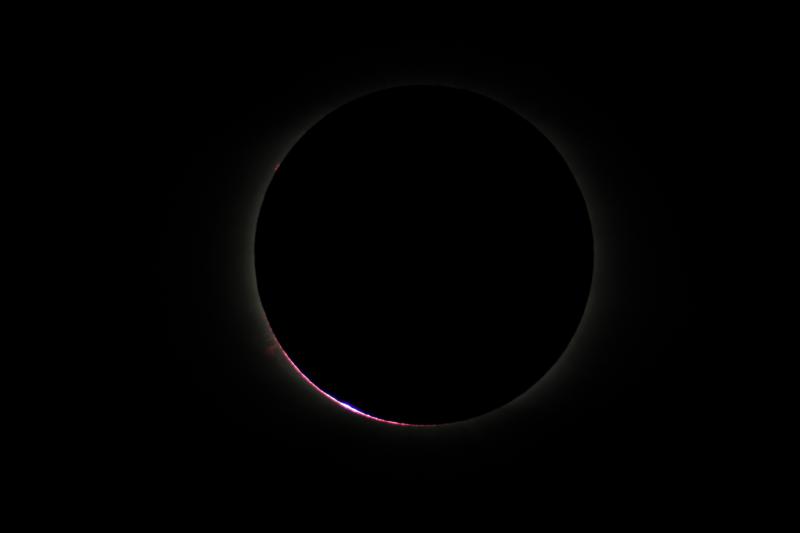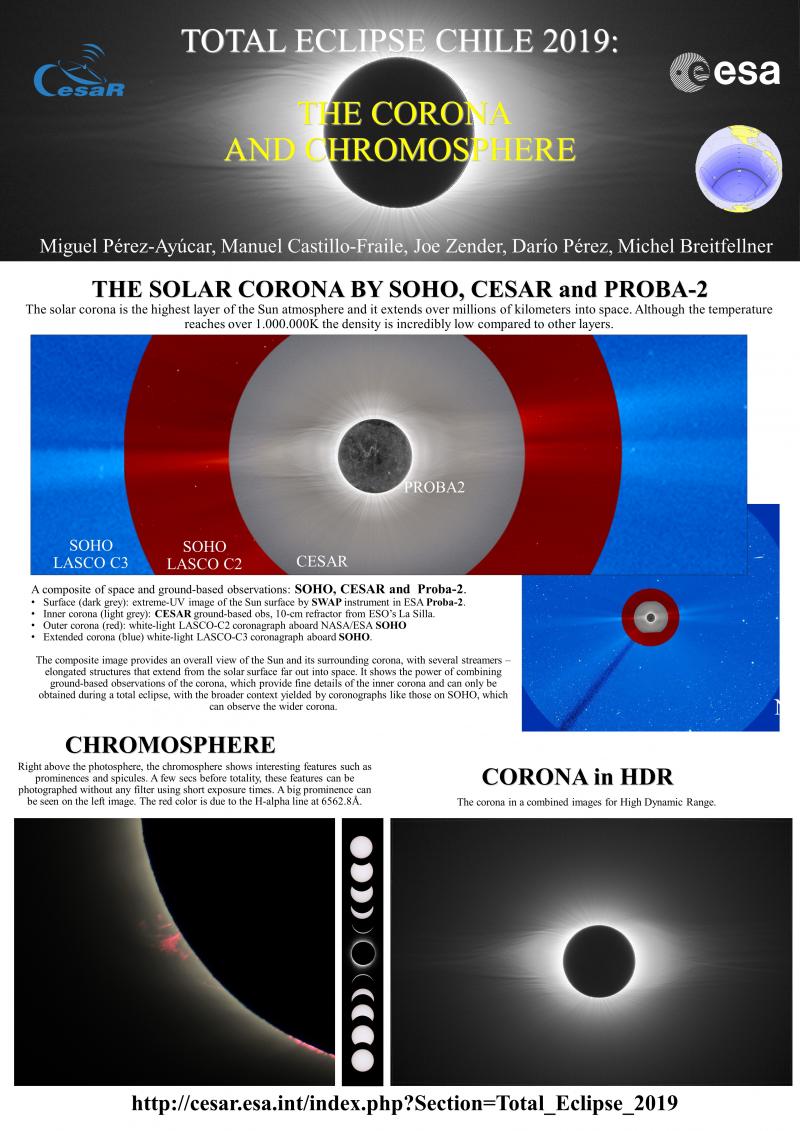(Printable version, go to full version)
 |
This is the Total Solar Eclipse 2019 results webpage, from the CESAR expedition to La SIlla Observatory, ESO, Chile, on 02-Jul-2019. CESAR organized a SPECIAL EVENT on the 02 July, 2019. A CESAR Expedition travelled to Chile to cover the event. It was broadcast LIVE from ESAC (European Space Agency Center) with live conections to Chile, experts talks and briefings, and Q&A. Totality happened at 22:42 local time in La SIlla, Chile, 20:42 in local time Europe CEST. More details on the preparations, location and equipment used in the expedition can be found here. Questions and answers for eclipses here. NOTE Images can be used under the terms and conditions of the CC BY-SA 3.0 IGO licence. Click on images for high-res versions. |
Full eclipse timelapse from recorded images:
Hangout recorded connection:
Live Sun recorded streaming:

NOTE Images can be used under the terms and conditions of the CC BY-SA 3.0 IGO licence.
Our greatest thanks to several teams that made possible this event:
- ESA-CESAR observing team @ La Silla
- ESA-CESAR team @ ESAC
- ESO organization and personnel (Xavier Barcons and his team)
- ESA science directorate (Gunther Hassinger)
- ESA-Comms @ ESAC and ESTEC
- ESA-GNSS Galileo Science Office
- University of Torino for the EKPOL instrument and interesting discussions.
- ESA faculty (camera for EKPOL experiment)
- Ralph Lorenz (UV measurements)
- Robert Nufer (somes of or team's cameras were controlled with Robert Nufer’s software SETnC (RobertNufer.ch) )
- Xavier M. Jubier (some of the cameras were controlled via Solar Eclipse Maestro).
- BepiColombo, Solar Orbiter, Proba-2, Proba-3 and Soho projects.
|
The beauty of the eclipse on a single frame. |
 |
| The eclipse timeline. A combination of separated images of the eclipse. |
|
Solar eclipse in context. Proba-2 (SWAP) - CESAR (polarization) - SOHO LASCO C2 - SOHO LASCO C3 (https://www.esa.int/spaceinimages/Images/2019/07/Solar_eclipse_in_context). |
|
A composite of space- and ground-based observations gathered at the time of the solar eclipse on 2 July 2019, combining imagery from the ESA/NASA SOHO and ESA's Proba-2 satellites with observations performed by the ESA-CESAR team in Chile.
At the centre, an extreme-ultraviolet image of the solar disc taken by the Royal Observatory of Belgium’s SWAP instrument aboard ESA’s Proba-2 mission shows the surface of the Sun (depicted in grey scale). The surrounding inner corona (also shown in grey scale) is revealed through ground-based observations obtained during the totality phase of the eclipse with a 10-cm refractor telescope (600mm focal lenght) at ESO’s La Silla Observatory in Chile. The outer corona is depicted through the white-light LASCO-C2 (shown in red) and C3 (shown in blue) coronagraph instruments aboard the ESA/NASA SOHO satellite. The composite image provides an overall view of the Sun and its surrounding corona, with several streamers – elongated structures that extend from the solar surface far out into space. It shows the power of combining ground-based observations of the corona, which provide fine details of the inner corona and can only be obtained during a total eclipse, with the broader context yielded by coronographs like those on SOHO, which can observe the wider corona. |
|
The polarized corona (https://www.esa.int/spaceinimages/Images/2019/07/Corona_details2) |
|
 |
|
| This image has been composed from different combinations of polarized images during totality, to bring out the details of the structures in the corona. | |
|
Chromosphere (https://www.esa.int/spaceinimages/Images/2019/07/Prominence) |
 |
| The Sun's Chromosphere. Image is raw (cropped), taken with visible-light telescope telescope (~f/1000), no filter, Canon 550D, during Moon's exit (third contact, C3). |
|
Sun's Corona in High Dynamic Range images (https://www.esa.int/spaceinimages/Images/2019/07/Corona_details) |
|
 |
 |
| Outer Corona. Lens: 400mm. Camera: Canon 6D. Processing: HDR using 3 images. | Outer Corona. Lens: 300mm. Filter: horizontal polarizer. Camera: Canon 60D. Processing: 6 image stacking and rotational gradient. |
 |
 |
| Inner Corona and Chromosphere. Lens: refraction telescope ~1000mm. Camera: Canon 550D. Processing: HDR using 3 images. | Inner Corona and Chromosphere. Lens: refraction telescope ~1000mm. Camera: Canon 550D. Processing: HDR using 3 images plus rotational gradient. |
|
Bailey's beads full sequence, leading to Diamond Ring. VIDEO please click here |
||||
 |
 |
 |
 |
 |
 |
 |
 |
 |
 |
 |
 |
 |
 |
 |
 |
 |
 |
 |
 |
| Baily's beads formation. Images are raw, taken with visible-light telescope telescope (~f/1000), no filter, Canon 550D, during Moon's exit (third contact, C3) | ||||
|
The eclipse in 3D (https://www.esa.int/spaceinimages/Images/2019/07/Eclipse_3D) |
  |
| The eclipse in 3D. The total solar eclipse of 2 July 2019, composed for viewing with red-green/blue '3D' anaglyph glasses. The image combines the first and last image during totality and has a subtle 3D effect. The right image is an animated GIF to show the actual images of the anaglyph and how much the moon moves |
|
Pinhole projection |
||
 |
 |
|
| Pinhole projection. Multiple suns are projected through pinholes, in this custom made ESA logo | ||
|
Stars identified in the corona region |
 Stars during totality. Several stars are identified within the extended corona, at distances less than 3 Sun's diameters |
TOTAL SOLAR ECLIPSE 02 AUG 2019 - PUBLICATIONS
At EPSC European Planetary Science Workshop. Geneva, Sep 2019
CESAR was present on the European Planetary Science Conference EPSC_2019, held 16-20 Sep 2019 in Geneva, Switzerland. CESAR presented their activities about the Solar Transits Special Events and related Education Outreach and Science.
The presented abstract can be found here.
More info on the 2017-EPSC publication in this link
At ESA Space Science Workshop SSW#12. Aranjuez, Nov 2019
Poster titles, abstracts and pdf links:
|
Poster 1 Solar corona and chromosphere |
Poster 2 Solar Corona Polarization and ionosphere |
Poster 3 The expedition |
Poster 4 Future total eclipses |
At ESA/ESO Sciops Workshop 2019 (#SCIOPS2019). ESAC, Nov 2019
TOTAL SOLAR ECLIPSE 02 JUL 2019 - still to do
| Still working on ... | ||
| - Visible, full eclipse (3h), all photos | - Corona, totality (2min), all photos |
|
| - Univ Torino polarization | (and more) .. | |
Other colleagues images
| Other pics from other colleagues | ||
 |
 |
|
| Bruno Altieri from ESO, La Silla. | Abel de Burgos (former team member, USA2017) from La Serena | Sara Nieto (ESAC), La Silla. |











